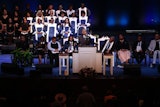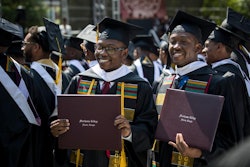North Carolina HBCU Evaluates Emerging Imaging Technology
By Ronald Roach
CHARLOTTE, N.C.
Researchers at Johnson C. Smith University (JCSU) have begun evaluating an emerging imaging technology that should yield advances in homeland security and aviation safety. The project, funded by the NASA Glenn Research Center in Ohio, has allowed the passive millimeter-wave (PMMW) imager to be built and delivered to JCSU for research. The technology is expected to open the door to new ways of handling airport security, aircraft landing, space shuttle diagnostics and battlefield combat.
“The passive millimeter-wave imager is a camera that can detect objects through clothing, dense fog, walls and other visibly opaque materials using millimeter-wave radiation. One advantage is its ability to see through severe weather conditions,” says Dr. Alan Lettington, professor emeritus at the University of Reading in the United Kingdom and a world-renowned scientist in the field of PMMW imaging.
Currently, most air traffic control systems and surveillance cameras use infrared waves, which are significantly weakened in poor weather. An advantage of the PMMW imager is that objects are not subject to external radiation in order to obtain an image.
“This technology makes it possible to detect objects without being detected — that’s why it’s called passive,” Lettington explains.
Four years ago, Dr. Magdy Attia, project director and JCSU department chair of computer science and engineering, collaborated with Lettington and the NASA Glenn Research Center to study and develop the PMMW imager. The camera was recently delivered to JCSU from the United Kingdom as a model for further research in the United States.
“Having this comprehensive engineering system at Johnson C. Smith provides an excellent training ground for our students to gain expertise in mm-wave technology, as well as opens research opportunities for faculty and other agencies,” Attia says, noting that JCSU students will begin conducting research projects on the technology this fall.
Since Sept. 11, 2001, potential applications and interest in the development of PMMW imaging has significantly increased. NASA, the U.S. Department of Defense and other national organizations are sponsoring research on the technology.
“Our primary interest in this technology is aviation safety. If aircraft control towers or airplanes can be equipped with mm-wave cameras, then even in adverse weather conditions, airports can remain open with the least loss of productivity,” says Dr. Isaiah M. Blankson, a senior scientist and technologist at NASA Glenn Research Center. “NASA (went) to Johnson C. Smith because there was real expertise in this area.”
The PMMW imagers are expensive due to the high cost of the millimeter-wave receivers needed to build them. A wide spectrum of knowledge is needed in order to do research in this field such as electromagnetic waves, microwave and millimeter-wave antennas and devices, automatic control systems, image reconstruction techniques, super-resolution algorithms, optimization methods, electronics circuits design and optics.
“Johnson C. Smith University has diligently worked to integrate technology into all aspects of our curriculum. With this project, we hope that others will not only recognize our commitment to technology, but also appreciate our focus on research,” says Dr. Dorothy Cowser Yancy, JCSU president.
© Copyright 2005 by DiverseEducation.com


















